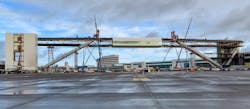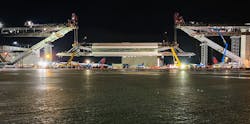A 780-ft-long pedestrian walkway is positioned over an active taxi lane at Sea-Tac International
Seattle Tacoma International Airport (Sea-Tac) is the nation’s 8th busiest. Last year, the international travelers it handled increased by 15% to account for 5.7 million of the airport’s 51 million passengers.
To provide those travelers with a welcoming environment, the Port of Seattle has been working with a Building Team that includes Clark Construction Group on the design and construction of a new $1 billion International Arrivals Facility (IAF), whose prominent features will include a 780-ft-long elevated pedestrian walkway that spans an active airport taxi lane to connect Sea-Tac’s new International Arrivals Hall with the airport’s South Satellite.
The walkway would be only the third such structure of its kind at any airport, and the world’s longest. (To put its size into perspective, it will be 150 ft longer than Seattle’s Space Needle.)
Its 85 ft of clearance and 610 ft of clear span between footings would be room enough for a 747 jet to get under.
Last month, Clark moved the walkway’s 320-ft-long, 3-million-lb center section into position, using self-propelled modular transport devices. That span was hoisted using four strand jacks, anchored to the walkway’s existing end spans. The end spans were engineered with eight inches of adjustment to fit together precisely to support the weight of the center section.
The bridge's center section was moved into position in the middle of the night using self-propelling modular transport devices.
With engineering tolerances between the side and center spans as small as one inch, it was imperative to understand how the three major sections of the walkway would come together before they were connected on site. Thanks to precise planning and laser scanning, the Building Team achieved a fit-up within 3/8 of an inch, enabling the walkway lift to occur without interruption.
Clark Construction Group is the design builder on this project, whose team members include KPFF (SE, Engineer of Record), Skidmore, Owings & Merrill (IAF designer), Schlaich Bergermann Partner (bridge designer), The Erection Company (walkway erector), Supreme Steel (steel fabricator), Mammoet (heavy transport), and KCE Structural Engineers (peer review).
The aerial walkway—which is scheduled for completion later this year—was designed as a cable-stayed bridge and the Accelerated Bridge Construction (ABC) method was applied for the build. The walkway is comprised of 17 components that were prefabricated offsite. (The structural steel alone weighs 3,000 tons.)

